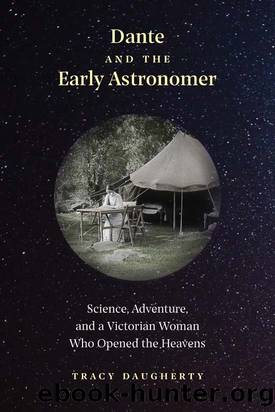Dante and the Early Astronomer by Tracy Daugherty;

Author:Tracy Daugherty;
Language: eng
Format: epub
ISBN: 9780300239898
Publisher: Yale University Press
Fig. 16. Dante’s universe as illustrated in Mary’s book Dante and the Early Astronomers.
In The Divine Comedy, Dante added a ninth heaven, the Primum Mobile, a crystalline sphere, luminous and transparent, that moves the angels. Mistakenly, in the Convivio (2.3.3–6) Dante attributed the idea of the Primum Mobile to Ptolemy. In fact, Arab astronomers created it initially to address the problem of precession, when planets and stars appear to revolve from east to west in a twenty-four-hour period (a result of Earth’s rotation). Mary says Dante’s mistake suggests that he never read Ptolemy directly, but knew him through secondhand sources, especially Alfraganus’s Elementa Astronomica, translated into Latin by Gerard of Cremona (c. 1114 – 1187).
It’s when Dante tries to describe the Empyrean, the abode of God and the angels beyond the Primum Mobile, that matters take a real twist.
Or—a curve.
Medieval Christians had established a tenth sphere, the heaven of God’s perfect light, where angels, saints, and the righteous dead dwelled forever. The problem was, if this realm lay beyond the Primum Mobile, just where was it? Aristotle had said the universe was finite. Most scholars agreed (though this caused a new fix—where and what was the edge of the universe? what happened there?). If the Empyrean wasn’t nestled within the visible heavenly spheres, did it float in a void—in nothingness? As we have seen, Aristotle rejected such notions, believing that the universe was finite and all its contents solid. But if the universe was finite, where was its place? How was place defined? Could the universe be both finite and unbounded at once? This seemed impossible.
It’s when Dante reaches the apparent edge of everything and begins his approach to God that he becomes most radical, conceiving a cosmos never seen before.
To fully appreciate Dante’s vision, we must leap forward in time for a moment, past Mary on her hilltop, to our own day. We need to adopt the equivalent of the angelic consciousness, keeping in mind past, present, and future.
In 1992, astronomers released a sky map of the Cosmic Microwave Background. Informally, they referred to this as the “afterglow of the Big Bang,” from the “time that light and matter parted ways.”13 George Smoot, a Nobel Laureate who led the research team, said, “If you’re religious, this is like looking at God.”14
Discovered in 1965 by the American radio astronomers Arno Penzias and Robert Wilson, the Cosmic Microwave Background is the earliest radiation that cosmologists have detected, left over from the Big Bang, and it fills the entire universe. According to the Big Bang theory, atoms could not exist under the intense temperatures and pressures characterizing the first 300,000 years of the universe. Instead, matter was distributed as ionized plasma—that is, a highly charged gas, featuring strong electromagnetic dynamics that scattered radiation. As the universe expanded, temperatures and densities dropped, so electrons and atomic nuclei were able to form atoms. At that point, photons—essentially, carriers of electromagnetic force—were able to escape what cosmologists tend to call the “fog of the early universe” and travel about, unfettered.
Download
This site does not store any files on its server. We only index and link to content provided by other sites. Please contact the content providers to delete copyright contents if any and email us, we'll remove relevant links or contents immediately.
| Ancient & Classical | Arthurian Romance |
| Beat Generation | Feminist |
| Gothic & Romantic | LGBT |
| Medieval | Modern |
| Modernism | Postmodernism |
| Renaissance | Shakespeare |
| Surrealism | Victorian |
4 3 2 1: A Novel by Paul Auster(11045)
The handmaid's tale by Margaret Atwood(6850)
Giovanni's Room by James Baldwin(5876)
Big Magic: Creative Living Beyond Fear by Elizabeth Gilbert(4723)
Asking the Right Questions: A Guide to Critical Thinking by M. Neil Browne & Stuart M. Keeley(4573)
On Writing A Memoir of the Craft by Stephen King(4212)
Ego Is the Enemy by Ryan Holiday(3989)
Ken Follett - World without end by Ken Follett(3972)
The Body: A Guide for Occupants by Bill Bryson(3797)
Bluets by Maggie Nelson(3707)
Adulting by Kelly Williams Brown(3667)
Guilty Pleasures by Laurell K Hamilton(3585)
Eat That Frog! by Brian Tracy(3512)
White Noise - A Novel by Don DeLillo(3434)
The Poetry of Pablo Neruda by Pablo Neruda(3364)
Alive: The Story of the Andes Survivors by Piers Paul Read(3309)
The Bookshop by Penelope Fitzgerald(3225)
The Book of Joy by Dalai Lama(3216)
Fingerprints of the Gods by Graham Hancock(3210)
